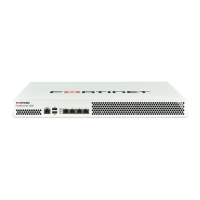Fine-tuning & best practices Page 123 FortiRecorder 2.4.2 Administration Guide
To mitigate impact in the event of a network compromise, always password-encrypt your
backups. If your operating system does not support this feature, you can encrypt the file using
third-party software.
Once you have tested your basic installation and verified that it functions correctly, create a
backup. Aside from being an IT best practice, this “clean” backup can be used to:
• troubleshoot a non-functional configuration by comparing it with this functional baseline (via
a tool such as diff)
• rapidly restore your installation to a simple yet working point (see “Restoring a previous
configuration”)
• batch-configure FortiRecorder appliances by editing the file in a plain text editor, then
uploading the finalized configuration to multiple appliances (see “Restoring a previous
configuration”)
After you have a working deployment, back up the configuration again after any changes. This
will ensure that you can rapidly restore your configuration exactly to its previous state if a
change does not work as planned.
To back up the configuration
1. Log in to the web UI as the admin administrator.
Other administrator accounts do not have the required permissions.
2. Go to Monitor > System Status > Status.
3. In the System Information widget, in the System configuration row, click Backup.
If your browser prompts you, navigate to the folder where you want to save the configuration
file. Click Save.
Your browser downloads the configuration file. Time required varies by the size of the file and
the speed of your network connection, but could take several seconds. The default file name
is <hostname>_YYYYMMDD.conf, where hostname is defined when you configure the mail
server settings (see “Configuring FortiRecorder to send notification email”) and YYYYMMDD
is the timestamp of the backup.
See also
• Restoring a previous configuration
• Restoring firmware (“clean install”)
• Resetting the configuration
• Updating the firmware
Configuration backups do not include backups of video data or logs. For information about
video backup, see “External storage”.

